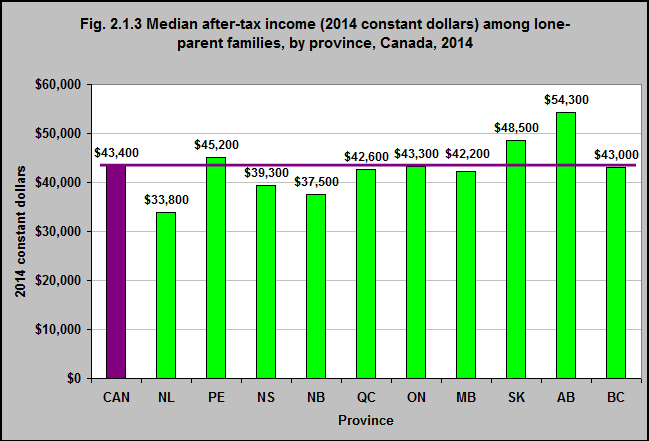Median after-tax income (2014 constant dollars) among lone-parent families, by province, Canada, 2014

Source: CICH graphic created using data adapted from Statistics Canada. Table 206-0011 – Market income, government transfers, total income, income tax and after-tax income, by economic family type, Canada, provinces and selected census metropolitan areas (CMAs), annual. http://www5.statcan.gc.ca/cansim/a26?lang=eng&retrLang=eng&id=2060011&&pattern=&stByVal=1&p1=1&p2=31&tabMode=dataTable&csid= – accessed March 17, 2017.
In 2014, the median after-tax income* in Canada was $43,400 for lone-parent families.
This varied between provinces – from a low of $33,800 in Newfoundland and Labrador to a high of $54,300 in Alberta.
In Canada overall the median after tax income for female-led lone-parent families was three-quarters that of male-led lone-parent families – $41,100 vs $58,100.1
1Statistics Canada. Table 206-0011 – Market income, government transfers, total income, income tax and after-tax income, by economic family type, Canada, provinces and selected census metropolitan areas (CMAs), annual. http://www5.statcan.gc.ca/cansim/a26?lang=eng&retrLang=eng&id=2060011&&pattern=&stByVal=1&p1=1&p2=31&tabMode=dataTable&csid=– accessed March 17, 2017.
*The concept of income covers income received while a resident of Canada or as relevant for income tax purposes in Canada. Market income is the sum of earnings (from employment and net self-employment), net investment income, private retirement income, and the items under other income. It is also called income before taxes and transfers. Total income refers to income from all sources including government transfers and before deduction of federal and provincial income taxes. It may also be called income before tax (but after transfers). After-tax income is total income less income tax. It may also be called income after tax. The median is the level of income at which half the population has higher income and half has lower.
